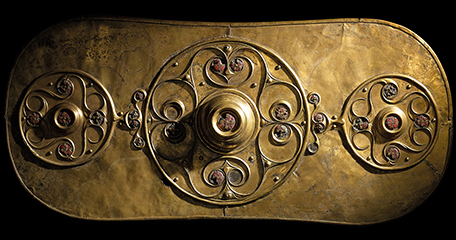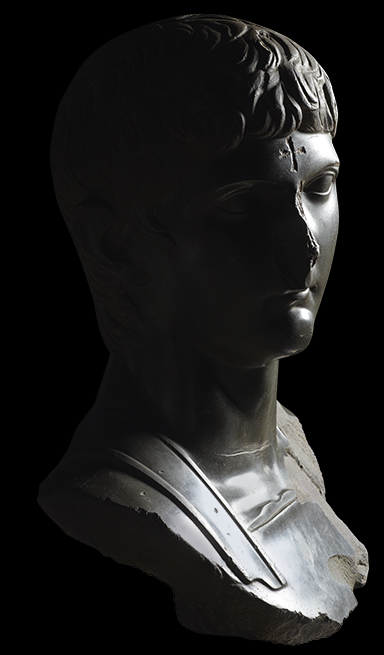by Oddbjørn Sørmoen*
There are two interesting exhibitions in the British Museum this winter: “Egypt: Faith after the pharaohs” and “Celts: Art and identity”. Both have relevance to us as members of Future for Religious Heritage, because they deal with the complex topic of religion as basis for cultural consciousness and identity.

Battersea Shield © British Museum
The religious history of Egypt is diverse. The famous massive pyramids are architectural remains that tell about mind-sets, beliefs and a culture long gone. This exhibition, however, tells the exiting story about the transformations of the Egyptian society after the pharaohs, a story that has relevance for our Europe today. What I find particularly interesting is how Egypt is used as a lens through which to examine the development and interaction between the three monotheistic faiths. This is not only a history of tension and conflict but very much also a history where the peaceful co-existence between the three is told. It starts with the flourishing Jewish culture, which has deep roots in Egypt, then goes on to the Christian, Coptic, which foundation is to be found in the Jewish, before it turns to the now dominant Muslim. The exhibition ends with the well-known pictures taken not long ago, from the turmoil in Egypt where Christians hold hands to protect the praying Muslims, and vice versa, at the Tahrir Square.
The diverse tangible heritage is what leads us through the exhibition, and makes us wonder, enjoy and understand. The objects themselves are vessels for the story. Without the objects, the ruins and the buildings, the story would often not have been known and less understood.
The Celtic exhibition shows how the material culture of the non-Roman peoples all over Europe binds them together and gives them their own distinct identity, which in due time is influenced and reformulated by Christian faith and practice. The Celtic identity has grown stronger in our recent past, seemingly more or less all over Europe. Both exhibitions show how important “materialized faith” has been for the history, and is for the understanding of the present.
Europe is in transition. The members of the European Union discuss how to cope with the waves of refugees from the Middle East and Northern Africa, the common currency, about closing borders, about the changing European identity and the future of the EU. The situation in Europe is extraordinary these days, but not for the first time. Dramatic changes have rolled over our part of the world many times before.
In 2017, Europe will commemorate the beginning of another time of transition for Europe: the Lutheran Reformation in 1517. The Reformation led to changes in religion and politics all over Europe, and it led to great artistic achievements as well as wars. To understand the European history and geography, one cannot come around the religious history and heritage, which is so evident in art and architecture not the least from the 16th century and the following centuries.

Germanicus © British Museum
Some months ago, I was fortunate to visit Silesia, the part of Poland close to the Czech Republic, close to the centre of the Reformation. A most interesting part of Europe, with a dramatic history up to our own time, not the least when it comes to religion. I celebrated Catholic mass in a church in Wroclaw, surrounded by protestant epitaphs, and a few days later I visited the enormous so-called Church of Peace in Swidnica, built after the Peace of Westphalia in 1648, which ended the Thirty Years’ War. The 7 500 seat huge, beautiful church is baroque Lutheran, and on the World Heritage List. These are only some examples of the importance religion has in understanding the history of Europe, and how important the objects and the buildings are for the storytelling.
What is new in our time, is that, in spite of some very painful exceptions, the European nations speak together, and do not take to arms, and try to sort out the problems. At the same time, we are even in our everyday lives constantly confronted with the religious heritage that is present in all European local communities. It often shows traces of the nerves that go through history. Those can be painful nerves or joyful nerves, but what matters most is that they bind us together with people of the past, and with Europeans and peoples of other nations and denominations.
Through the tangible objects on show, the two exhibitions in the British Museum, “Egypt: Faith after the pharaohs” and “Celts: Art and identity”, visualise how complex this relationship with the past and with other regions actually is. And it is once again a testimony how important it is to save the religious heritage of Europe, because it has such great potential for building identity, vital as a common denominator.
Oddbjørn Sørmoen
Director of Department for Church Buildings and Heritage administration
KA, Norway
* Oddbjørn Sørmoen, Norvegian, is FRH Council member since October 2015. He is part of the group that set up FRH in Canterbury in 2010, and was one of the main organisers of the FRH conferences in Venice 2012 and Halle 2014. He is director of Department for Church Buildings and Heritage Management in the NGO KA Association for Employers in the Church of Norway.





Follow us: